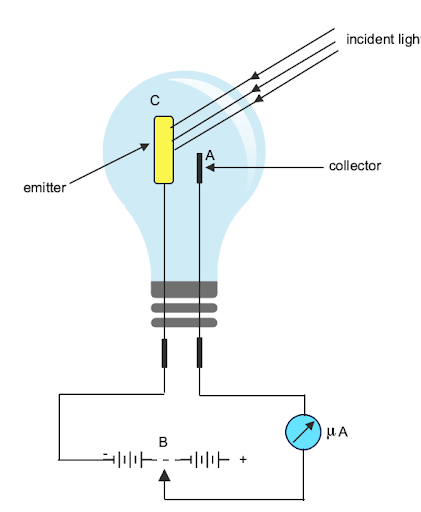
Assertion: In photo emissive cells inert gas is used.
Reason: Inert gas in the photo emissive cell gives greater current.
A. If both assertion and reason are true and the reason is the correct explanation of the assertion.
B. If both assertion and reason are true but reason is not the correct explanation of the assertion.
C. If the assertion is true but the reason is false.
D. If the assertion and reason both are false
Answer
218.7k+ views
Hint: Based on the photoelectric effect, photo-emissive cells emit light. A substance releasing or containing electrically charged particles as a result of absorbing electromagnetic radiation. We first understand about the photocell and its working to answer this question.
Complete step by step solution:
First, understanding what a photoelectric cell is, often known as a photocell, is an electronic gadget that transforms light energy into electrical energy using the photoelectric effect as its basis. The earliest method of converting light into energy is using photoemissive cells.

It comprises evacuated glass or quartz bulbs with an anode and cathode made of two metallic electrodes. Anode A is a thin rod or wire held along the axis of semi-cylindrical cathode C, which is semicircular in shape and coated with photosensitive material. Through the galvanometer, the potential difference is applied between cathode and anode.
When the electrons are released, the anode will draw them, which causes the current to move and be detected by the galvanometer. The amount of incident radiation and the potential difference between the cathode and anode will determine how much current is generated.
The photo emissive cell may be evacuated to release a low-pressure inert gas. Greater current is produced by an inert gas inside the cell, but this compromises the cell's ability to react quickly to changes in radiation, which may make it inappropriate for particular applications.
Hence option A is correct.
Note: Photo emissive cells are compact, affordable, low power, simple to operate, and durable. Photovoltaic and photoconductive cells are distinct from phototube and photoelectric cells, which are the same as photoemissive cells. Helium, neon, argon, or another inert gas is used to fill the cell's bulb.
Complete step by step solution:
First, understanding what a photoelectric cell is, often known as a photocell, is an electronic gadget that transforms light energy into electrical energy using the photoelectric effect as its basis. The earliest method of converting light into energy is using photoemissive cells.

It comprises evacuated glass or quartz bulbs with an anode and cathode made of two metallic electrodes. Anode A is a thin rod or wire held along the axis of semi-cylindrical cathode C, which is semicircular in shape and coated with photosensitive material. Through the galvanometer, the potential difference is applied between cathode and anode.
When the electrons are released, the anode will draw them, which causes the current to move and be detected by the galvanometer. The amount of incident radiation and the potential difference between the cathode and anode will determine how much current is generated.
The photo emissive cell may be evacuated to release a low-pressure inert gas. Greater current is produced by an inert gas inside the cell, but this compromises the cell's ability to react quickly to changes in radiation, which may make it inappropriate for particular applications.
Hence option A is correct.
Note: Photo emissive cells are compact, affordable, low power, simple to operate, and durable. Photovoltaic and photoconductive cells are distinct from phototube and photoelectric cells, which are the same as photoemissive cells. Helium, neon, argon, or another inert gas is used to fill the cell's bulb.
Recently Updated Pages
A square frame of side 10 cm and a long straight wire class 12 physics JEE_Main

The work done in slowly moving an electron of charge class 12 physics JEE_Main

Two identical charged spheres suspended from a common class 12 physics JEE_Main

According to Bohrs theory the timeaveraged magnetic class 12 physics JEE_Main

ill in the blanks Pure tungsten has A Low resistivity class 12 physics JEE_Main

The value of the resistor RS needed in the DC voltage class 12 physics JEE_Main

Trending doubts
JEE Main 2026: Application Form Open, Exam Dates, Syllabus, Eligibility & Question Papers

Understanding Uniform Acceleration in Physics

Derivation of Equation of Trajectory Explained for Students

Hybridisation in Chemistry – Concept, Types & Applications

Understanding the Angle of Deviation in a Prism

Understanding Collisions: Types and Examples for Students

Other Pages
JEE Advanced Marks vs Ranks 2025: Understanding Category-wise Qualifying Marks and Previous Year Cut-offs

Understanding Atomic Structure for Beginners

How to Convert a Galvanometer into an Ammeter or Voltmeter

Understanding Centrifugal Force in Physics

JEE Main Marking Scheme 2026- Paper-Wise Marks Distribution and Negative Marking Details

Degree of Dissociation: Meaning, Formula, Calculation & Uses




